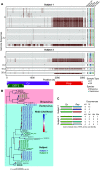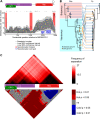Redondovirus Diversity and Evolution on Global, Individual, and Molecular Scales
- PMID: 34406857
- PMCID: PMC8513488
- DOI: 10.1128/JVI.00817-21
Redondovirus Diversity and Evolution on Global, Individual, and Molecular Scales
Abstract
Redondoviridae is a newly established family of circular Rep-encoding single-stranded (CRESS) DNA viruses found in the human ororespiratory tract. Redondoviruses were previously found in ∼15% of respiratory specimens from U.S. urban subjects; levels were elevated in individuals with periodontitis or critical illness. Here, we report higher redondovirus prevalence in saliva samples: four rural African populations showed 61 to 82% prevalence, and an urban U.S. population showed 32% prevalence. Longitudinal, limiting-dilution single-genome sequencing revealed diverse strains of both redondovirus species (Brisavirus and Vientovirus) in single individuals, persistence over time, and evidence of intergenomic recombination. Computational analysis of viral genomes identified a recombination hot spot associated with a conserved potential DNA stem-loop structure. To assess the possible role of this site in recombination, we carried out in vitro studies which showed that this potential stem-loop was cleaved by the virus-encoded Rep protein. In addition, in reconstructed reactions, a Rep-DNA covalent intermediate was shown to mediate DNA strand transfer at this site. Thus, redondoviruses are highly prevalent in humans, found in individuals on multiple continents, heterogeneous even within individuals and encode a Rep protein implicated in facilitating recombination. IMPORTANCERedondoviridae is a recently established family of DNA viruses predominantly found in the human respiratory tract and associated with multiple clinical conditions. In this study, we found high redondovirus prevalence in saliva from urban North American individuals and nonindustrialized African populations in Botswana, Cameroon, Ethiopia, and Tanzania. Individuals on both continents harbored both known redondovirus species. Global prevalence of both species suggests that redondoviruses have long been associated with humans but have remained undetected until recently due to their divergent genomes. By sequencing single redondovirus genomes in longitudinally sampled humans, we found that redondoviruses persisted over time within subjects and likely evolve by recombination. The Rep protein encoded by redondoviruses catalyzes multiple reactions in vitro, consistent with a role in mediating DNA replication and recombination. In summary, we identify high redondovirus prevalence in humans across multiple continents, longitudinal heterogeneity and persistence, and potential mechanisms of redondovirus evolution by recombination.
Keywords: CRESS viruses; Redondoviridae; brisavirus; evolution; genetic recombination; redondovirus; rep protein; vientovirus.
Figures






References
-
- Abbas A, Taylor LJ, Dothard MI, Leiby JS, Fitzgerald AS, Khatib LA, Collman RG, Bushman FD. 2019. Redondoviridae, a family of small, circular DNA viruses of the human oro-respiratory tract associated with periodontitis and critical illness. Cell Host Microbe 25:719–729. 10.1016/j.chom.2019.04.001. - DOI - PMC - PubMed
Publication types
MeSH terms
Substances
Grants and funding
- T32 AI007532/AI/NIAID NIH HHS/United States
- 9299/Wenner-Gren Foundation (WGF)
- R33HL137063-S1/HHS | NIH | National Heart, Lung, and Blood Institute (NHLBI)
- P30 AI045008/AI/NIAID NIH HHS/United States
- BCS-1540432/National Science Foundation (NSF)
- R33HL137063/HHS | NIH | National Heart, Lung, and Blood Institute (NHLBI)
- 1-19-VSN-02/American Diabetes Association
- 5T32AI007532-18/HHS | NIH | National Institute of Allergy and Infectious Diseases (NIAID)
- R35 GM134957/GM/NIGMS NIH HHS/United States
- R33 HL137063/HL/NHLBI NIH HHS/United States
- T32AI007324/HHS | NIH | National Institute of Allergy and Infectious Diseases (NIAID)
- R25 GM071745/GM/NIGMS NIH HHS/United States
- T32 AI007324/AI/NIAID NIH HHS/United States
- R25GM071745/HHS | NIH | National Institute of General Medical Sciences (NIGMS)
- R35GM134957-01/HHS | National Institutes of Health (NIH)
LinkOut - more resources
Full Text Sources

